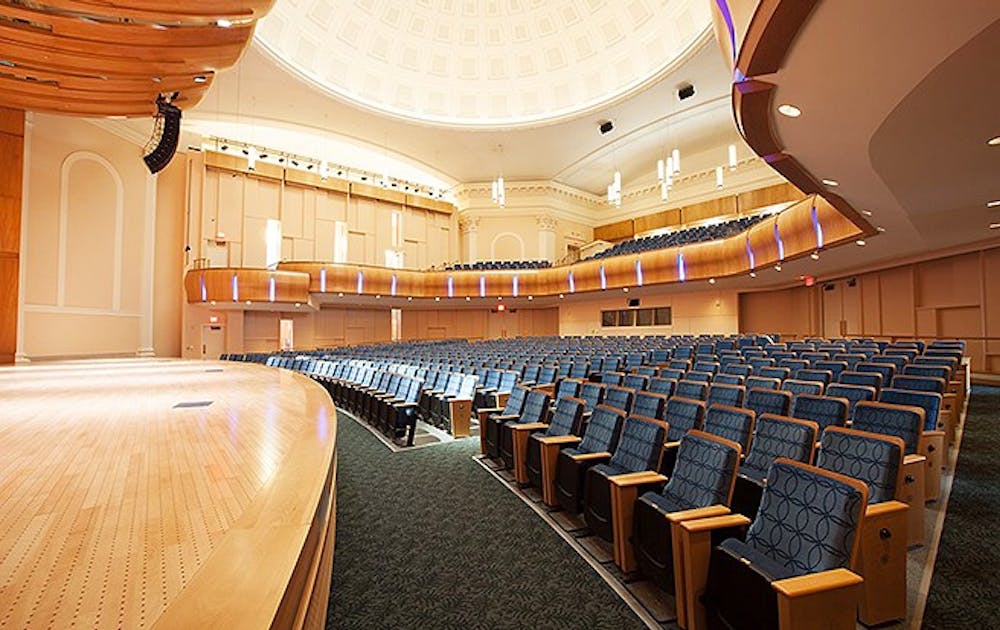At 7:30 p.m, Dec. 7, Duke Symphony Orchestra (DSO) will be hosting their second full concert and fourth show of the year at Baldwin Auditorium. To learn more about the event, The Chronicle interviewed DSO Publicity Chair David King. DSO is a full orchestra with between seventy to eighty members, a string section and smaller wind and bass sections. DSO is composed primarily of undergraduate and graduate students, with some members from the wider Duke community. It is relatively unique in that it is both a social organization and a half-credit class that meets twice a week for practice.
Three songs have been selected for performance at the concert: Ferenc’s Overture No. 1 in E Minor, Op. 23 (1834), Dvorak’s Cello Concerto in B Minor, Op. 104 (1894-95) and Brahms Symphony No. 3 in F Major, Op. 90 (1883). Ferenc’s Overture — overtures are orchestral pieces played at the opening of a longer composition – is a quick ten-minute piece known for its multiple fast moving sections, well blended rhythms and beautiful melodies. It is particularly notable as one of the few Romantic era — from the late 1700s to early 1800s when music sought to be emotional, dramatic and individualistic — pieces composed by a woman. Ferenc was a forgotten composer for most of history despite her accomplished skills as a composer and pianist. The Dvorak Concerto is famed for being one of the best cello concertos, which are musical compositions written for cello soloists accompanied by orchestras. It is more orchestrally heavy and focuses less on the soloist compared to traditional cello concerto, which strikes a good balance between the orchestra and soloist. For the cello solo, DSO has invited guest cellist David Atkins, an Associate Professor of Cello at Oberlin College and a famed cellist who has played with many respected orchestras. The final piece, Brahms Symphony — with symphonies being elaborate compositions for full orchestra that usually have four movements and at least one sonata movement — is an emotionally heavy, dark and moody piece that is known for its ending. While symphonies tend to end with large and dramatic endings, Brahms has a softer ending likened by King to a breath being released.
According to King, all the pieces chosen are great, but his favorites are the Ferenc Overture and the Dvorak Cello Concerto. He finds the Ferenc Overture particularly noteworthy. DSO is rarely given the opportunity to play such an exceptional piece as this one by a female composer, since the majority of classical music work is composed by or published under the name of men. He also likes the Dvorak Cello Concerto, as the increased role of the orchestra makes it fun for both the cellist and orchestra. Additionally, it presents a challenge while allowing DSO to play with one of the country’s best soloists.
When asked why students should go to the concert, King gave four reasons. The first is that each student will have friends who are among the musicians in DSO and they would appreciate some support and encouragement. The second is that there will be multiple pieces of powerful music played and the invaluable opportunity to see many distinguished musicians perform. Additionally, the songs chosen are welcoming and will be enjoyable to all, even those inexperienced with or less enthusiastic about classical music. Last of all, students will be able to grab free refreshments at the post-performance reception. Needless to say, the concert will provide students with a much-needed break from the final grind and show students one of the many fascinating experiences that Duke has to offer.
Get The Chronicle straight to your inbox
Sign up for our weekly newsletter. Cancel at any time.
Zev van Zanten is a Trinity junior and recess editor of The Chronicle's 120th volume.

